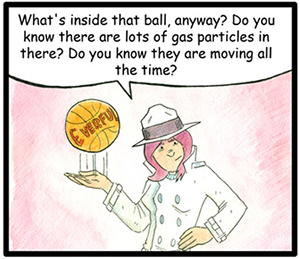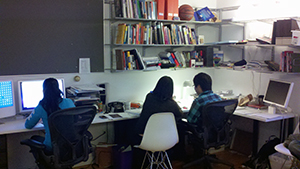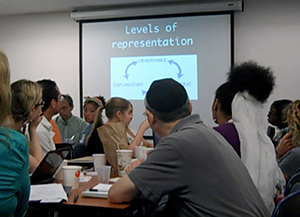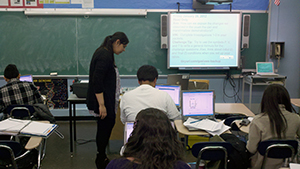Addressing the Needs of Science Education

There is a critical need in science education for students to experience science as a process of inquiry and exploration, in which they organize information around concepts and principles—“big ideas”—rather than memorizing facts. To that end, there is enormous potential for using multimedia to support active learning, contextualization, and visualization—all recommended as best practices for science education.
Materials incorporating these three approaches require careful design, and none of the approaches can be considered in isolation. To create increasingly effective chemistry simulations, Molecules & Minds employs a theoretically and empirically based process of iterative design that draws on high school students and teachers as research partners.
Teaching and Learning Philosophy

The Molecules & Minds simulations originated from a specific set of questions about how to design multimedia resources that support teaching and learning.
First, learning is an active process, and it is only through vigorous, personal engagement with content that students productively construct knowledge. The job of educators, then, is to provide students with opportunities for guided exploration, allowing them to personally investigate the answers to a multitude of questions.
Second, authentic understanding of chemical principles is best attained and characterized by connecting different levels of representation: observable, explanatory and symbolic. The narrative elements of the Molecules & Minds simulations are designed to provide students opportunities to connect real-world phenomena to visualized particle actions and graphical representations of simulation variables.
Finally, model-based inquiry fosters the active process of learning chemical concepts by allowing students to investigate, assess, and create models of chemical interactions themselves. When provided with the three levels of representation available in the simulations, each student can develop understandings for themselves.
Theoretical Cognitive Science Underpinnings
Several theoretical models inform the Molecules & Minds simulation designs and research.

The Cognitive Theory of Multimedia Learning (CTML; Mayer, 2001) assumes that:
- Auditory and visual information are perceived and processed in separate but mutually supportive channels
- Each channel’s function is limited by working memory
- Humans are not passive recipients of knowledge, but must actively process information
Cognitive Load Theory(CLT) is a model based on working memory research, which describes the capacity limitations of the human cognitive architecture in processing information (Sweller, 1994; 1999).
Schema Theory (Bartlett, 1932), is based on the claim that, grounded in prior knowledge, schemata are basic memory structures that continuously adapt as the individual “actively constructs knowledge and understanding through interactions between new knowledge and previous knowledge” (Myhill & Brackley, 2004).
The Design and Evaluation Process

We began crafting the Molecules & Minds simulations in 2006 and used them to explore how aspects of their design influence student learning. In an iterative process, students and teachers use the simulations under both classroom and laboratory conditions, and then the efficacy of the simulations is quantitatively and qualitatively gauged relative to student-level factors.
To complete each cycle, the research team of professors, students, and programmers in educational technology, science education, educational psychology and cognitive science interrogate experimental and usability results with respect to theoretical framing and refine the simulations accordingly.
Areas of Focused Effort

Reducing Cognitive Load - Molecules & Minds simulations streamline use of graphic and textual information to reduce the amount of cognitively-distracting secondary content.
Modes of Representation - Molecules & Minds simulations purposefully link students' everyday experiences of phenomena with the embedded particulate models shown and the symbolic representation available through graphing of student data collection.
Scaffolding - In order to facilitate productive use of the simulations, the designs include features which help guide users to learn how to use the simulations more easily and create connections between disparate aspects of the simulations and with student experiences. Examples of these "scaffolds" include visual cues to draw attention from one item to a related item, and comic strip narratives, which contextualize particulate models in everyday phenomena.
Some Central Research Questions

- Which specific design features and learning strategies are most effective in multimedia science resources for secondary school students?
- Over and above specific prior knowledge, what characteristics do individual learners bring to the learning environment?
- Will a series of simulations designed with specific attention to the structure and limitations of human cognitive architecture, best science teaching practices, and the context of the high school classroom improve learning and student attitudes when integrated into intact high school chemistry classrooms?
- How effective are visual and other types of scaffolds in engendering effective student-simulation interactions?
- Beyond the consideration of whether scaffolds will be effective, for which learners will they be most appropriate?
Our design is based on evidence obtained from experiments to test which design elements best support student learning.